
A Pocket PC is a class of personal digital assistant (PDA) that runs the Windows Mobile or Windows Embedded Compact operating system that has some of the abilities of modern desktop PCs. The name was introduced by Microsoft in 2000 as a rebranding of the Palm-size PC category. Some of these devices also had integrated phone and data capabilities, which were called Pocket PC Phone Edition. Windows "Smartphone" is another Windows CE based platform for non-touch flip phones or dumber phones.
The O2 Xda brand was a range of Windows Mobile PDA phones, marketed by O2, developed by O2 Asia and manufactured by multiple OEMs (mainly HTC, Quanta and Arima). The first model was released in June 2002. The last models came to market in 2008. The "X" represents convergence of voice and information/data within one product; the "DA" stands for "Digital Assistant", as in PDA. The name of XDA Developers is derived from it.
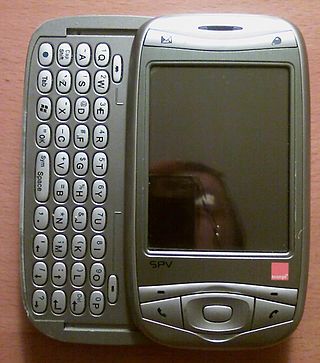
The HTC Wizard is an Internet-enabled Windows Mobile Pocket PC smartphone designed by High Tech Computer Corporation of Taiwan. It has a touchscreen with a left-side slide-out QWERTY keyboard. The Wizard's functions include those of a camera phone and a portable media player in addition to text messaging and multimedia messaging. It also offers Internet services including e-mail, instant messaging, web browsing, and local Wi-Fi connectivity. It is a quad-band GSM phone with GPRS and EDGE. There are variants which differ in the design of the case, the keyboard and the presence of an on-board camera. On AT&T/Cingular, the Wizard was superseded by the HTC TyTN, known as the AT&T/Cingular 8525. On T-Mobile USA, the Wizard was superseded by the HTC P4350, known as the T-Mobile Wing.

The HTC Universal is a Windows Mobile 5.0 Pocket PC PDA manufactured by High Tech Computer Corporation. It was the first 3G/UMTS-enabled Pocket PC PDA with a telecommunications function, and also the first to come with Windows Mobile 5.0 pre-installed.

The HTC Prophet is a combined Personal Digital Assistant (PDA) and mobile telephone manufactured by HTC.

The HTC TyTN is an Internet-enabled Windows Mobile Pocket PC PDA designed and marketed by High Tech Computer Corporation of Taiwan. It has a touchscreen with a left-side slide-out QWERTY keyboard. The TyTN's functions include those of a camera phone and a portable media player in addition to text messaging and multimedia messaging. It also offers Internet services such as e-mail, instant messaging, web browsing, and local Wi-Fi connectivity. It is a quad-band GSM phone with GPRS, and EDGE, and a single/dual band UMTS phone with HSDPA. It is a part of the first line of PDAs directly marketed and sold by HTC. On AT&T/Cingular, the TyTN was the successor to the HTC Wizard, known as the Cingular 8125. Also on AT&T, the TyTN was superseded by the HTC TyTN II, known as the AT&T 8925 and the AT&T Tilt.

The HTC Magician is a Windows Mobile 2003 Second Edition PDA-phone, manufactured by High Tech Computer Corporation and released in December 2004. It is sold by many different vendors under the names of Qtek S100, O2 Xda II Mini (Asia), O2 Xda mini (Germany), T-Mobile MDA compact, i-mate JAM, Vodafone VPA Compact, Dopod 818, Krome Spy, and Orange SPV M500. Despite the names and appearances all have the same hardware specifications. The i-mate Jam has a slightly different fascia which requires modification to be retrofitted to other magicians.
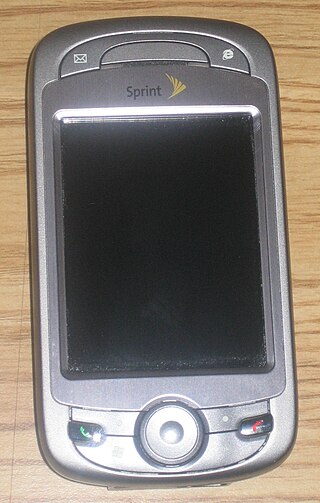
The HTC Titan is a Windows Mobile 6.1 Pocket PC PDA and phone manufactured by High Tech Computer Corporation of Taiwan. It is the successor to the HTC Apache upon which it improves by adding more ROM, GPS, EVDO Rev. A, additional hard keys, a scroll-wheel, spring-loaded keyboard, and a higher resolution camera. The Windows Mobile 6.1 operating system includes Office Mobile along with HTML email through Microsoft Outlook Mobile. Windows Media Player is included, allowing the Titan to act as a digital audio and digital movie player.

The Xperia X1 is a high-end smartphone from Sony Ericsson, and is the first in the manufacturer's Xperia series. The phone was designed and built by Taiwanese OEM HTC. The X1 was first presented at the 2008 Mobile World Congress.
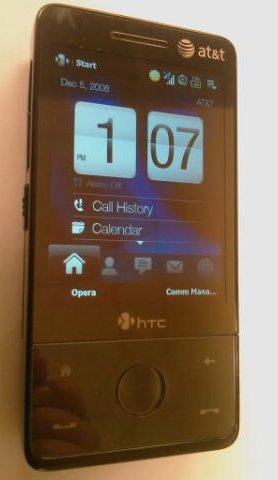
The HTC Touch Pro is a smart phone from the Touch series of Internet-enabled Windows Mobile Pocket PC smartphones designed and marketed by HTC Corporation of Taiwan. It is an enhanced version of the HTC Touch Diamond with the addition of a left-side slide-out QWERTY keyboard, a microSD card slot, and a camera flash. The Touch Pro smartphone's functions include those of a camera phone and a portable media player in addition to text messaging and multimedia messaging. It also offers Internet services including e-mail, instant messaging, web browsing, and local Wi-Fi connectivity. Depending on its market, it is a quad-band GSM or quad-band UMTS phone with GPRS, EDGE, UMTS, HSDPA, and HSUPA or a tri-band CDMA phone with 1xEV-DO Rev A. All versions feature TouchFLO 3D — a new enhanced version of the TouchFLO interface, unique only to the latest Touch series. In March 2009, HTC announced a new version, the Touch Pro2 which has a larger screen (3.6") and a redesigned slide out QWERTY keyboard with spaces between the keys.

XDA is a mobile software development community launched on 20 December 2002. Although discussion primarily revolves around Android, members also talk about many other operating systems and mobile development topics.
The XDA Flame is a Pocket PC device first released in May 2007, produced by Arima Communications and originally distributed by O2 Asia Pacific & Middle East. This device belongs to a wide O2 Xda device family, including XDA Atom, XDA Atom Life, XDA Zinc, XDA Orbit, XDA Stealth, XDA II Mini, XDA IIs, XDA II and XDA. It is one of the first Pocket PC device that was enabled with 3D accelerated graphics nVidia's GoForce 5500 graphic processor (GPU). XDA Flame is also a 3G enabled phone with VGA touch screen, 2GB flash memory, 128MB RAM, Intel XScale PXA 270 520 MHz processor and integrated FM radio.

This is a comparison of the various internal components and features of many smartphones.

The HTC Touch Pro2 is a slate smartphone, part of the Touch series of Internet-enabled, Windows Mobile, Pocket PC smartphones designed and marketed by HTC Corporation of Taiwan. It is an enhanced version of the HTC Touch Pro with a left-side slide-out QWERTY keyboard, with tilting screen. The Touch Pro2 smartphone's functions include those of a camera phone and a portable media player in addition to text messaging and multimedia messaging. It also offers Internet services including e-mail, instant messaging, web browsing, and local Wi-Fi connectivity. Visual voicemail is not a standard feature for the Touch Pro2, unlike its predecessor the Touch Pro. The Verizon Wireless version does include a visual voicemail application, however. All versions feature TouchFLO 3D — a new enhanced version of the TouchFLO interface, unique only to the latest Touch series. The latest update renamed TouchFLO 3D to SenseUI, to match HTC's Android offering. The Touch Pro2 — along with its sister model, the Touch Diamond2 — were unveiled on February 16, 2009 in Barcelona, Spain at the Mobile World Congress 2009. Specific enhancements over the original Touch Pro include:
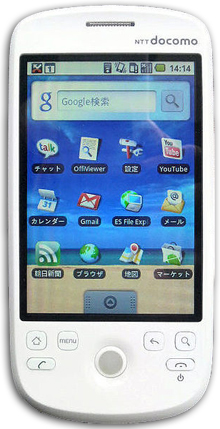
HTC Magic is an Android smartphone designed and manufactured by HTC. It is HTC's second Android phone after HTC Dream, HTC's first touch-only flagship Android device and the second Android phone commercially released, as well as the first Android phone without a keyboard.
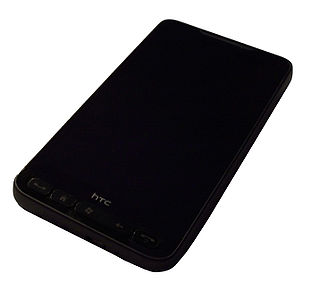
The HTC HD2, is a smartphone in the HTC Touch family designed and manufactured by HTC. The HD2 natively runs the Windows Mobile 6.5 operating system, and was released in Europe in November 2009, in Hong Kong in December 2009, and in other regions including North America in March 2010. The phone is the successor to the HTC Touch HD, and is succeeded by the HTC HD7.
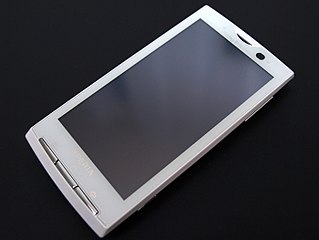
The Sony Ericsson Xperia X10 is a 2010 high end smartphone in the Xperia series designed by Sony Ericsson. It was the first Sony Ericsson smartphone to run the Android operating system. The phone was shipped with Android 1.6 (Donut), but an upgrade to 2.1 (Eclair) was made available starting 31 October 2010, with a gradual international rollout. Originally, Sony Ericsson stated that the X10 would not receive an upgrade to Android 2.2 (Froyo) or beyond, but the phone was later upgraded to 2.3.3 (Gingerbread) with the updates starting on 29 July 2011.

The HTC Evo 4G is a smartphone developed by HTC Corporation and marketed as Sprint's flagship Android smartphone, running on its WiMAX network. The smartphone was launched on June 4, 2010. It was the first 4G enabled smartphone released in the United States.
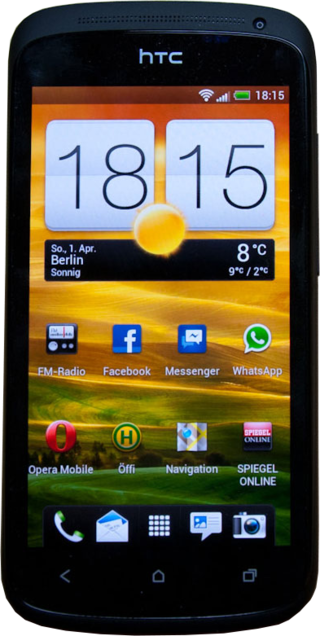
The HTC One S is a premium smartphone designed and manufactured by HTC as part of the HTC One series which has Beats Audio and runs the Android 4.0 "Ice Cream Sandwich" mobile operating system with HTC Sense. Announced by HTC on 26 February 2012, the HTC One S was scheduled for official release on 2 April 2012. The first phones were sold on March 30. In the United States, the One S is carried by T-Mobile and Solavei.

















